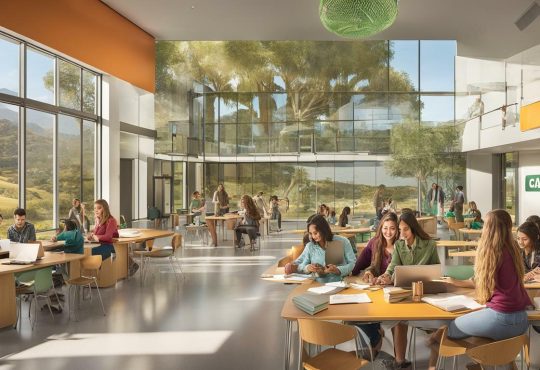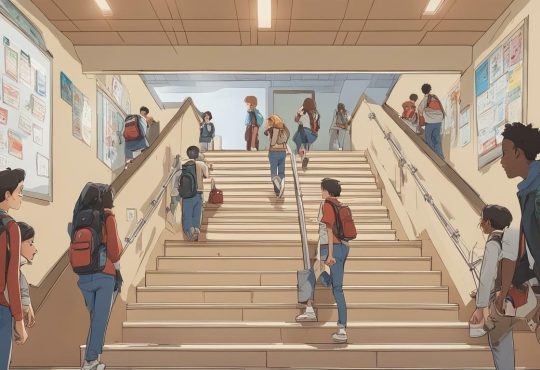
How To Make Time Go Faster At School
Do you ever find yourself staring at the clock, counting down the minutes until your next class? Whether you’re in middle school or college, school days can seem to drag on forever. Fortunately, there are numerous tips and strategies that can help make time go faster and maximize your productivity in the classroom.
In this section, we will explore some of the most effective techniques for speeding up time at school. From time management strategies to active learning techniques, you’ll learn how to make the most of your school days and enhance your academic experience.
Key Takeaways:
- By implementing time management techniques, students can stay organized and make their school days feel more productive.
- Incorporating engaging activities into the classroom routine can help minimize boredom and make time go by faster.
- Developing effective note-taking techniques and prioritizing tasks can help students save time and maximize productivity.
Time Management Techniques for Students
Effective time management is crucial for making time go faster at school. By adopting practical strategies and techniques, students can manage their time more efficiently and make their school days feel more productive.
Creating a Schedule
One of the most effective time management techniques is creating a schedule. This involves setting aside specific times for studying, completing assignments, and attending classes. By doing so, students can ensure they have enough time to complete all tasks, while also optimizing their productivity and minimizing stress levels.
Eliminating Distractions
Distractions can be a significant hindrance to effective time management. Students must identify and eliminate distractions, such as social media notifications, TV shows, or unnecessary phone calls. By doing so, they can focus on important tasks and complete them more efficiently.
Setting Realistic Goals
It’s essential to set realistic goals that align with your schedule and priorities. By breaking down larger tasks into smaller, achievable goals, students can maintain motivation and make steady progress. These goals can include completing a set amount of reading, writing, or studying, depending on individual needs and preferences.
Prioritizing Tasks
Students should prioritize their tasks based on their importance and urgency. This can involve ranking tasks in order of importance, assigning deadlines, and dedicating the most time and energy to high-priority tasks. This approach ensures that students stay on track and don’t waste time on less crucial tasks, ultimately making their school days feel more productive.
Eliminating Procrastination
Procrastination can be a significant impediment to effective time management. Students must identify what causes procrastination and work on minimizing it. This can involve breaking down larger tasks, setting smaller goals, and rewarding oneself after completing specific tasks.
By implementing these time management techniques, students can make their school days feel shorter, more productive, and less stressful. Effective time management is a crucial skill that can help students succeed academically and in their future careers.
Engaging Activities to Minimize Boredom
Feeling bored can make time drag on, especially during long school days. However, there are several activities that you can incorporate into your routine to minimize boredom and keep your mind engaged. Here are some effective strategies:
1. Participate in Class Discussions
Active participation in class discussions can make the subjects more interesting and help you retain information more effectively. Engage in discussions by asking relevant questions, sharing your opinions, and providing examples from your own experiences.
2. Join Extracurricular Activities
Extracurricular activities are an excellent way to break the monotony of school days. Join clubs or organizations related to your interests or passions. Participating in sports or other physical activities can also help you stay energetic and focused throughout the day.
3. Create Interactive Notes
Instead of taking traditional notes, try creating interactive notes that involve different colors, diagrams, and images. This technique can help you remember information more effectively and make studying more engaging.
4. Practice Mnemonics
Mnemonics are a great way to make learning more fun. These techniques involve creating associations between information to help you remember it more effectively. For example, you can use acronyms like “ROYGBIV” to remember the colors of the rainbow.
5. Play Educational Games
Playing educational games can be a great way to make learning more enjoyable. There are several educational games available online that are both fun and informative. Challenge your classmates to a friendly competition and see who can score the highest.
By incorporating these activities into your daily school routine, you can minimize boredom and make time go by quickly. Remember to stay engaged and actively participate in classroom activities to get the most out of your time at school.
Efficient Studying Methods for Faster School Days
Students can spend an ample amount of time studying and still not achieve the desired results. This is because students are not taught how to study effectively. In this section, we will provide some tips and tricks on how to study smartly and efficiently to make the most of your school days.
The Pomodoro Technique
The Pomodoro Technique is a time management method that can help students stay focused and motivated while studying. This technique involves setting a timer for 25 minutes and working on a task for that entire period. After the 25 minutes, take a five-minute break and then resume working on the task. After completing four Pomodoro cycles, take a longer break of 15-30 minutes. By breaking up study sessions into intervals, students can stay focused and avoid burnout.
Active Recall
Active recall is a learning technique that involves testing your knowledge on a subject by recalling information from memory. This technique is more effective than passive learning methods, such as rereading notes or textbooks. Students can use active recall techniques such as flashcards, quizzes, and summarizing notes to retain information better and improve their studying efficiency.
Interleaving
Interleaving is a studying method that involves mixing up different topics or subjects to enhance retention and understanding. This technique involves studying multiple subjects or topics simultaneously instead of focusing on one at a time. By interweaving different subjects, students can make connections between different concepts and remember information more effectively.
These efficient studying methods can help students achieve better results in less time, making school days feel shorter and more productive.
Setting Realistic Goals
Setting realistic goals is an essential ingredient in maximizing productivity in school. It helps students stay motivated, focused, and organized, making it easier to make the most of their time in school.
When setting goals, it’s important to be specific and measurable. Instead of setting a general goal like “do well in math,” consider setting a specific goal like “score an A on the next math quiz.” This way, you have a clear idea of what you want to achieve and can easily track your progress.
It’s also important to set achievable goals. While it’s great to aim high, setting unrealistic goals can lead to frustration and burnout. Start by setting small goals that you know you can achieve, then gradually increase the difficulty over time.
Another helpful tip is to focus on one goal at a time. Trying to achieve too many goals at once can lead to feeling overwhelmed and spread thin. Prioritize your goals and focus on the most important one first.
Remember to celebrate your accomplishments along the way. Reward yourself when you achieve a goal, no matter how small. It will help you stay motivated and make the journey more enjoyable.
Creating a Productive Study Environment
Studying in a distracting environment can significantly slow down your pace and make time feel like it’s crawling. To ensure productive studying, students need to create an environment that’s conducive to concentration and focus. Here are some tips on creating a study-friendly setting:
- Designate a study space: Choose a quiet and comfortable place at home, like a separate room or a desk in your bedroom, to study in without distractions.
- Organize your study materials: Ensure that all the study materials, like textbooks, notes, and stationery, are readily available before you begin to study.
- Eliminate distractions: Turn off the TV, mute notifications on your phone, and close all irrelevant tabs on your computer to avoid interruptions during study hours.
- Control the lighting: Ensure that your study space has sufficient lighting – natural light is the best – and avoid studying in dimly lit areas, which can cause strain and drowsiness.
- Optimize sound: If you’re sensitive to noise, wear earplugs or noise-canceling headphones to reduce external sounds. On the other hand, if you need ambient noise to concentrate, try playing soft background music or white noise.
Creating an ideal study space can help speed up your study sessions, which translates into shorter school days. By implementing these hacks, you’ll be able to focus better on your academic tasks while saving yourself from the mental stress of prolonged school hours.
Developing Effective Note-Taking Techniques
Note-taking is a crucial skill for academic success. By taking effective notes, students can retain information efficiently and make better use of their study time. Here are some tips to help you develop effective note-taking techniques:
1. Use Abbreviations
Using abbreviations can save time and keep your notes concise. Common examples include “w/” for “with,” “b/c” for “because,” and “i.e.” for “that is.” However, make sure that your abbreviations are easy to understand and don’t affect the clarity of your notes.
2. Create a System of Symbols
Incorporating symbols into your notes can help you differentiate between important concepts and supporting details. For example, you might use an asterisk (*) to denote crucial ideas, a triangle (∆) to signify examples, and an exclamation mark (!) to indicate points of emphasis.
3. Use Visual Aids
Visual aids can help you organize your notes and make them more memorable. You might use diagrams, charts, or mind maps to illustrate complex ideas or relationships between concepts.
4. Record Main Points
Your notes should focus on the main points of the lecture or reading material. Avoid recording every detail, as this can be overwhelming and time-consuming. Instead, try to identify the most important ideas and concepts and record them in a clear and concise manner.
5. Review and Revise Your Notes
Reviewing and revising your notes regularly can help reinforce your understanding of the material and improve your retention. Take the time to clarify any confusing or unclear points, and make any necessary additions or revisions to your notes.
By using these effective note-taking techniques, you can make the most of your study time and improve your academic performance.
Prioritizing Tasks
Time management is all about prioritizing tasks. It’s important to identify which tasks are most important and require immediate attention. By focusing on high-priority tasks first, you can make better use of your time and ensure a faster-paced school day. However, it can be challenging to determine which tasks to prioritize. Here are some tips to help you prioritize tasks efficiently:
- Identify urgent tasks: Tasks that require immediate attention are considered urgent. For example, a deadline for an assignment that’s due the next day. These tasks should be at the top of your list.
- Determine the importance of tasks: Some tasks may not be urgent but are still important. For example, studying for an upcoming exam. Determine the importance of such tasks and prioritize them accordingly.
- Break down larger tasks: Larger tasks can be overwhelming, and it may be challenging to determine where to start. Break down these tasks into smaller, manageable chunks, and prioritize them based on urgency and importance.
- Use a priority matrix: A priority matrix is a tool that can help you determine which tasks to prioritize based on urgency and importance. Create a matrix and categorize tasks based on their urgency and importance.
Prioritizing tasks allows you to manage your time efficiently and ensures that you’re working on tasks that are most important and require immediate attention.
Incorporating Breaks and Rewards
It’s no secret that taking breaks and rewarding yourself can help make time go faster. Incorporating regular breaks during study sessions can help alleviate stress and improve focus. But what types of breaks should you take?
Short breaks are best when studying for long periods of time, ideally 5 to 10 minutes every hour. During these breaks, it’s important to step away from your study materials and do something relaxing, like stretching or taking a short walk. This can help clear your mind and improve focus for when you return to your studies.
When it comes to rewards, it’s important to choose something that will motivate you to stay focused and productive. Set achievable goals for yourself, such as finishing a chapter or completing a set of practice problems, and reward yourself when you accomplish them. Rewards can be small, like allowing yourself to check social media for 10 minutes or treating yourself to a snack.
By incorporating breaks and rewards into your study routine, you can create a sense of accomplishment and make time go by faster. Just be sure to strike a balance between work and relaxation to maximize productivity.
Improving Focus and Concentration
Maintaining focus and concentration is crucial to making time go by faster in the classroom. However, it can be challenging to stay engaged for extended periods. Here are some practical techniques to improve focus and concentration:
- Eliminate distractions: Turn off your phone and avoid browsing social media during class.
- Take regular breaks: Take short breaks during study sessions to recharge your brain.
- Practice mindfulness: Clear your mind and focus on the present moment to stay engaged during class.
- Develop effective study habits: Create a schedule and study routine to help train your brain to focus.
By incorporating these techniques into your daily routine, you can improve your ability to concentrate and stay engaged, making time go by faster in the classroom.
Incorporating Active Learning Strategies
Active learning strategies can help students engage more deeply with the subject matter and make time go faster in the classroom. By actively participating in class discussions, group activities, and practical exercises, students can enhance their learning experience. Below are some effective active learning strategies:
| Active Learning Strategies | Description |
|---|---|
| Group Work | Working in small groups encourages collaboration and helps students learn from each other’s perspectives. It also allows for personalized feedback and helps students develop essential communication and team-building skills. |
| Discussion-based Learning | Encouraging discussion-based learning promotes critical thinking and analysis. It helps students develop communication and argumentative skills, while also providing a platform for interacting with peers and fostering a deeper understanding of the subject matter. |
| Problem-based Learning | Problem-based learning involves actively solving problems related to the subject matter. This approach encourages students to think creatively and analytically, while also developing essential problem-solving skills. It also helps students take ownership of their learning experience and promotes a sense of autonomy and independence. |
Implementing active learning strategies can make the classroom experience more engaging and interactive, making time go faster while increasing the quality of learning.
Tricks for Altering Time Perception
Perception of time can be a strange thing. Sometimes it feels like hours have flown by, while at other times, minutes can drag on like eternity. Fortunately, there are various tricks and techniques that can help alter time perception, making school hours feel shorter and more manageable.
Take Mini Breaks
Taking mini breaks throughout the day can help break up the monotony of a long school day. When you’re constantly engaged in the same activity, time can fly by without you even realizing it. So, try taking a short break every hour or so. Use this time to stretch, move around, or grab a quick snack. By doing so, you’ll feel refreshed and ready to tackle the next task on your to-do list.
Engage in Enjoyable Activities
When you’re doing something you enjoy, time often flies by. So, try incorporating enjoyable activities into your daily routine. For example, if you love drawing, try doodling in your notebook during breaks between classes. If you love music, listen to your favorite playlist during your commute to school. By engaging in activities that you enjoy, you’ll be more likely to lose track of time and feel like the day went by faster.
Break Tasks into Smaller Chunks
Big tasks can feel overwhelming and never-ending. However, breaking them into smaller, more manageable chunks can make them feel less daunting and help time pass by more quickly. For example, if you have a big research paper due at the end of the week, break it down into smaller tasks, such as creating an outline, writing the introduction, and researching sources. By focusing on one small task at a time, you’ll feel less overwhelmed and like you’re making progress, which can help time go faster.
With these tricks and techniques, you can alter your perception of time and make school hours feel more manageable. By breaking up the monotony, engaging in enjoyable activities, and breaking tasks into smaller chunks, you’ll feel like time is flying by and before you know it, the school day will be over.



